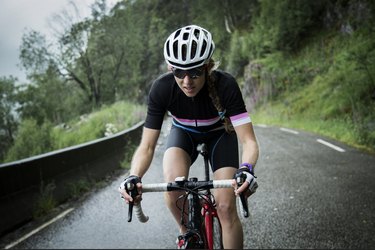
Riding a bike does not help you to run faster. This is primarily because of differences in the way your muscles are used in biking and running as well as the specific patterns of movement required for each activity. In order to become a faster runner, you have to train by running. Adding cycling to your training regimen will not help you achieve faster run times, though it can be used as an effective cross-training tool if used properly.
The Specificity and Variation Principles
Video of the Day
The specificity principle states that in order for you to become a faster runner, you need to replicate the specific movement patterns required for that activity. The more specific the better. In order to run faster, you would need to consistently train by running drills designed to increase speed such as intervals, which are bursts of speed followed by controlled periods of recovery, and tempo runs, which are runs performed slightly above your comfort zone. Joe Friel, a triathlete coach and author, told "The New York Times" that he tells his athletes to give up cycling for awhile if they want to improve their run times. The variability principle seems to contradict the specificity principle by asserting that varying activity is desirable for recovery and to avoid the stresses of a single sport. The answer lies in the degree of variation. Specific training is always better when it comes to faster running; however, variation of sport when you are not actively training or at low intensity during training to assist your muscles in recovery may be helpful.
Video of the Day
Muscle Groups Used in Cycling Versus Running
Both cycling and running use most of the same lower-body muscle groups, but the way they use them is different. Cycling requires a smooth rotational cadence of your legs, while your upper body supports the motion through isometric contraction. Check out your bulging triceps the next time you're climbing a big hill. Your lower back and abdominals act as a stabilizing bridge between your upper and lower body. Your hips remain in alignment throughout the ride. Running puts a far greater weight-bearing load on your joints and also causes greater torque through your lower back and hips by continually having one leg in front of the other. Your upper body should remain as relaxed as possible.
Muscle Fatigue
Cycling is believed by some exercise trainers, physiologists and professional athletes to actually hinder running performance. Try moderate to strenuous cycling anywhere from 10 to 25 miles and then immediately follow up with a short 1- to 2-mile run. Your legs will feel heavy and leaden and your pacing will feel forced. This is because both of these activities use some of the same muscle groups and quickly switching from cycling to running means these muscles are likely to already be fatigued. Efficient cycling requires large, developed quadriceps, adding unwanted weight to a runner's legs. The inflammation of muscle fibers in your legs from a tough cycling workout may deter your ability to run faster even days later. Some professional triathletes who have crossed over to marathon training will completely lay off the bike while training for the long run.
Recovery and Speed Training
Recovery is one of the most critical components of your run training. Without proper rest and recovery, all your hard training will be for nothing. You also run the risk of injury and forced time off from training. Training to become a faster runner puts a tremendous amount of stress on the body. Further fatiguing your leg muscles by mixing moderate to strenuous cycling sessions with your running workouts in order to become faster could backfire by not allowing muscles to adequately recover and causing you to become a less efficient and more injury prone runner. Conversely, cycling used as a method in maintaining your overall cardiovascular fitness while recovering from a injury that temporarily sidelines you from running or as a recovery tool after a strenuous run, using very light resistance to decrease the heaviness in your legs, may be useful.